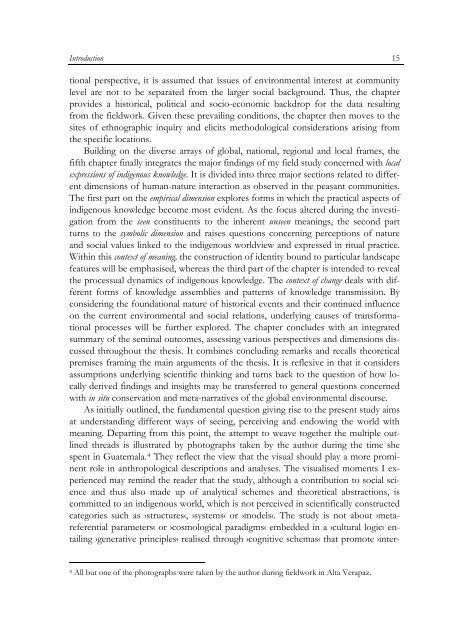The cultural context of biodiversity conservation - Oapen
The cultural context of biodiversity conservation - Oapen
The cultural context of biodiversity conservation - Oapen
You also want an ePaper? Increase the reach of your titles
YUMPU automatically turns print PDFs into web optimized ePapers that Google loves.
Introduction<br />
tional perspective, it is assumed that issues <strong>of</strong> environmental interest at community<br />
level are not to be separated from the larger social background. Thus, the chapter<br />
provides a historical, political and socio-economic backdrop for the data resulting<br />
from the fieldwork. Given these prevailing conditions, the chapter then moves to the<br />
sites <strong>of</strong> ethnographic inquiry and elicits methodological considerations arising from<br />
the specific locations.<br />
Building on the diverse arrays <strong>of</strong> global, national, regional and local frames, the<br />
fifth chapter finally integrates the major findings <strong>of</strong> my field study concerned with local<br />
expressions <strong>of</strong> indigenous knowledge. It is divided into three major sections related to different<br />
dimensions <strong>of</strong> human-nature interaction as observed in the peasant communities.<br />
<strong>The</strong> first part on the empirical dimension explores forms in which the practical aspects <strong>of</strong><br />
indigenous knowledge become most evident. As the focus altered during the investigation<br />
from the seen constituents to the inherent unseen meanings, the second part<br />
turns to the symbolic dimension and raises questions concerning perceptions <strong>of</strong> nature<br />
and social values linked to the indigenous worldview and expressed in ritual practice.<br />
Within this <strong>context</strong> <strong>of</strong> meaning, the construction <strong>of</strong> identity bound to particular landscape<br />
features will be emphasised, whereas the third part <strong>of</strong> the chapter is intended to reveal<br />
the processual dynamics <strong>of</strong> indigenous knowledge. <strong>The</strong> <strong>context</strong> <strong>of</strong> change deals with different<br />
forms <strong>of</strong> knowledge assemblies and patterns <strong>of</strong> knowledge transmission. By<br />
considering the foundational nature <strong>of</strong> historical events and their continued influence<br />
on the current environmental and social relations, underlying causes <strong>of</strong> transformational<br />
processes will be further explored. <strong>The</strong> chapter concludes with an integrated<br />
summary <strong>of</strong> the seminal outcomes, assessing various perspectives and dimensions discussed<br />
throughout the thesis. It combines concluding remarks and recalls theoretical<br />
premises framing the main arguments <strong>of</strong> the thesis. It is reflexive in that it considers<br />
assumptions underlying scientific thinking and turns back to the question <strong>of</strong> how locally<br />
derived findings and insights may be transferred to general questions concerned<br />
with in situ <strong>conservation</strong> and meta-narratives <strong>of</strong> the global environmental discourse.<br />
As initially outlined, the fundamental question giving rise to the present study aims<br />
at understanding different ways <strong>of</strong> seeing, perceiving and endowing the world with<br />
meaning. Departing from this point, the attempt to weave together the multiple outlined<br />
threads is illustrated by photographs taken by the author during the time she<br />
spent in Guatemala. 4 <strong>The</strong>y reflect the view that the visual should play a more prominent<br />
role in anthropological descriptions and analyses. <strong>The</strong> visualised moments I experienced<br />
may remind the reader that the study, although a contribution to social science<br />
and thus also made up <strong>of</strong> analytical schemes and theoretical abstractions, is<br />
committed to an indigenous world, which is not perceived in scientifically constructed<br />
categories such as ›structures‹, ›systems‹ or ›models‹. <strong>The</strong> study is not about ›metareferential<br />
parameters‹ or ›cosmological paradigms‹ embedded in a ›<strong>cultural</strong> logic‹ entailing<br />
›generative principles‹ realised through ›cognitive schemas‹ that promote ›inter-<br />
4 All but one <strong>of</strong> the photographs were taken by the author during fieldwork in Alta Verapaz.<br />
15

















